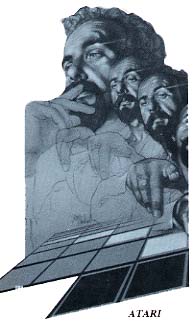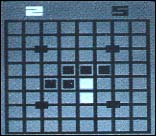OTHELLO
BY MARTHA KOPPIN

|
DESCRIPTION
Othello is a game for Atari freaks who have more brain than brawn. You may already know it as a board game.
The game board is a grid of 64 squares. At the start of the game, two black markers and two white markers are at the center of the board. Squares are captured by positioning one of your markers on each side of your opponent's marker or markers. This can be done in a horizontal, vertical or diagonal row, and only those markers which touch each other are captured. Markers can change colors any number of times, depending on who captured them last. Only moves that result in the capturing of your opponent's men are legal. Detailed instructions are given in the Othello Game Program Instruction booklet.
JOYSTICK CONTROLLERS
Move the joystick in the direction you wish to move the cursor (the flashing square that indicates where the next marker will be). When you have positioned the cursor, push the red button to place your marker on that square. A nasty buzzer will sound if you attempt an illegal move (Atari hates cheaters).
SCORING
Each captured square is worth one point, but it is difficult to predict the outcome of any game based soley on the score at any given time. Since the squares change color as they are captured and recaptured, the score changes accordingly.
PLAYING STRATEGY
Amassing great numbers of squares is not as important as securing key locations. The most important squares to occupy are the four outer corners, as they not only assist in capturing the remainder of the outside rows (Area Number 3, which is of secondary importance), but are themselves safe from capture. The inner 16 squares (Area Number 1) are filled up first because they provide safe positions which cannot be used as bridges to capture the outside squares.

|
In positioning your markers in the outside rows, try to put them together in the middle of the row, avoiding the squares second from the end (unless you have already captured the adjacent corner). Avoid leaving one empty square between outside row markers, as your opponent can place his marker safely between the two and may be able to capture some of your spaces. Two empty spaces between your markers are better than one, since you can quickly capture your opponent's marker if he should try to occupy one of these spaces.
The empty space adjacent to the corners becomes valuable to you if your opponent occupies all of the surrounding spaces except for the far corner space. If you can capture this second-to-last space, then the far corner space can also be occupied, capturing all of the interior spaces.
Avoid positioning your marker in Area Number 2, as this can make a handy bridge for your opponent to get to the outside rows. Eventually, you will have to move in this area, but put it off as long as possible and position your marker so that if your opponent gets to the outside, he will at least be in the square adjacent to the corner (assuming the rest of the outside row is empty). Hopefully, you will be able to use him to capture the corner.
VARIATIONS
There are no variations of this game, only degrees of intelligence in your opponent.
|